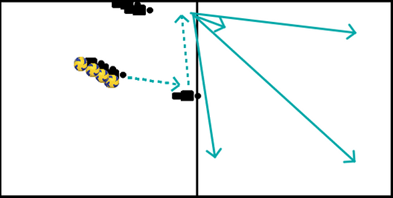Volleyball drills for technique setting / overarm technique
This exercise starts reasonably simple and is then gradually expanded (can be done in 1 training session or spread over several sessions). An exercise in which everyone must defend, set and attack.
It is a long piece of text, but it is easier than the length of the text suggests. Just do it!
Requirements:
It is a long piece of text, but it is easier than the length of the text suggests. Just do it!
Requirements:
- at least 2 ballsminimum
- 8 players (preferably an even number)
Part 1
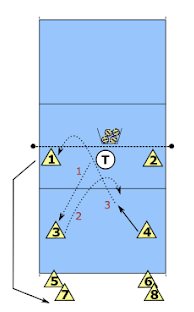
It starts with two players at the net (1 and 2), two players in the backfield (3 and 4) and the rest behind the backline. The trainer stands at the net in the middle position with two balls.
Once the players know the patterns, this exercise can be done at a fast pace.
- The trainer throws or hits the ball towards player 3 (1 ). Player
- 3 passes the ball to the middle of the field about on the 3 meter line (2).
- Player 4 runs in and gives a setup to the left front (3 ).
- Player 1 catches the ball, throws the ball in the ballcarrier and runs to the backline and connects with the back.
- The trainer throws or punches the ball towards player 4. Player
- 4 passes the ball to the middle of the field about on the 3 meter line.
- Player 3 runs in and gives a setup to the right front.
- Player 2 catches the ball, throws the ball in the ballcarrier and runs to the backline and connects with the back.
- Player 3 goes to the left front and player 4 turns to the right front.
Once the players know the patterns, this exercise can be done at a fast pace.
Part 2
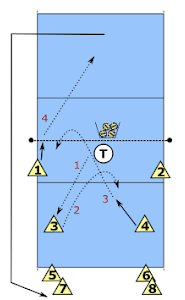
- The trainer throws or hits the ball towards player 3 (1 ). This is the moment that players 1 and 2 run backwards to make an attack.
- Player 3 passes the ball to the middle of the field about on the 3 meter line (2 ).
- Player 4 runs in and gives a setup to the left front (3 ).
- Player 1 smashes the ball over the net (4
- The trainer throws or hits the ball towards player 4. Player
- 4 passes the ball to the middle of the field about on the 3 meter line.
- Player 3 runs in and gives a setup to the right front.
- Player 2 smashes the ball over the net, picks it up and puts it in the ballcarrier of the trainer. Then player 2 runs to the backline and joins the backline.
- Player 3 goes to the left front and player 4 turns to the right front.
Part 3
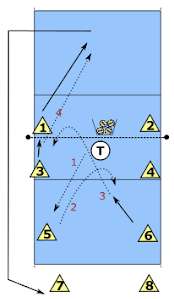
The exercise now starts with 6 players in the field. There are now two more blockers, who stand at the other side of the net.
- The trainer throws or hits the ball towards player 5 (1 ). This is the moment that players 3 and 4 run backwards to make an attack.
- Player 5 passes the ball to the middle of the field about on the 3 meter line (2 ).
- Player 6 runs in and gives a setup to the left front (3 ).
- Player 3 smashes the ball over the net (4 ).
- Player 1 tries to block the smash.
- The trainer throws or hits the ball towards player 6. Player
- 6 passes the ball to the middle of the field about on the 3 meter line.
- Player 5 runs in and gives a setup to the right front.
- Player 4 smashes the ball over the net. Player
- 2 tries to block the smash.
- Player 5 moves to the left front and player 6 turns to the right front.
- Player 3 and 4 move to the blocking positions.
- Player 1 and 2 get the ball in the ballcar and go to the backline.
Part 4
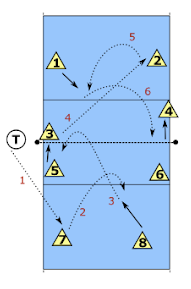
There are now 8 players in the field. The trainer only throws the first ball, then the game continues.
The same patterns as in the previous sections are executed: the players in the backfield take care of the pass and the setup. The players at the net smashem and block.
If there are more than 8 players, the game continues after, say, 10 attacks or so.
The same patterns as in the previous sections are executed: the players in the backfield take care of the pass and the setup. The players at the net smashem and block.
If there are more than 8 players, the game continues after, say, 10 attacks or so.
- One of the two players stands at the net, the other in the backfield. The players play over BH, with an in-between ball.
- After the signal of the coach the ball must be played to the other side. The ball must be turned in during the interim test.
- After the signal of the trainer the ball must be turned half a turn during the in-between try.
- After the signal of the trainer the first ball must be received underhand, the ball to the other must remain above hand.
- One player stands on the left front side and comes walking up to the middle (after a hit on the ball from the trainer) and gives a set up for or behind the back (trainer indicates).
- Trainer throws the ball to the trainer or one of the players at the front of the court.
- Set up a basket on the right and left side in front of the court where the ball has to be played into.
- After the set up, fetch the ball.
- Two persons one ball and one tennisball.
- One plays the ball overhand and the other throws the tennis ball to the other.
- This can also be done underhand.
- Pairs facing each other with a net in between
- Overhead smash,
- start on the 3,
- with every good ball 1 step back,
- to the backline
- Two one ball
- Overlap
- one time for yourself and
- then pass
Setup: Each player has a ball.
Everyone walks through each other, bouncing a ball, and carries out the following tasks.
Signals + command
- On 1: bounce the ball to the right.
- At 2: bounce the ball to the left
- At 3: ba with both hands on collision
- Follow your way with the other hand.
- Pick up the ball with 1 or 2 hands after bounce
- Leave your own ball behind after bounce as quickly as possible to intercept another ball
More leaning towards keys:
- After dribbling ball catch own ball above head, then throw ball into air again without letting ball drop under eyes.
- Same as before, hold for 1 second
- Same as first, shorten contact
- Idem, but first catch the ball, then touch it away
- Ditto, but with double key
Game Form 1B:
During:
- The serve: the ball is thrown into play with both hands.
- Catching the ball with both hands above the head.
- Throwing the ball in front of himself (without dropping below the level of the eyes) and then overplaying it with an overhand touch.
Next:
- 2 feet out of the field, where the player wants: left - right - back
- Variation: touch a cone each time the ball crosses the net.
Notes:
- Throw the ball back where you caught it (do not run with the ball in your hands).
- Do not hold the ball in your hands for more than 2 seconds.
- Standing still when the ball is caught (and perhaps aiming).
Form 1C:
During:
- Picking the ball out of the air with one hand, making one collision and a second collision through a basketball dribble with one hand, high enough to play overhead. (One or two control keys may be used to play).
- Picking should be done as high as possible.
Next:
- 2 feet out of the court, where the player wants (left - right - back)
- Variant: move one of the two tennis balls placed on the 2 cones (at the back of the field).
Formation: 2 balls per 4 players
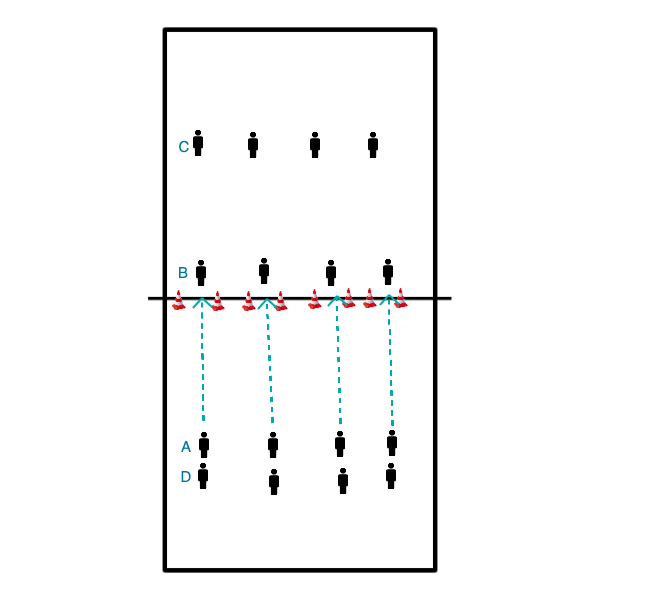
1.
- Player A (bowling motion) rolls the ball to player B (the ball must pass between the 2 cones!!).
- Player B picks up the ball, bounces it 2 times and then plays it in a bow to player C.
- Player C holds a hoop and puts the hoop down at the spot where the ball is going to collide. The ball is caught after 1 collision. Player C grabs the ball and joins player D at the back.
- Everyone follows their ball = moves up one place.
2.
- Player A throws the ball under the net to player B.
- Player B catches the ball, bounces once high, does a control key and then bounces to player C.
- Player C catches the ball low to the ground in the correct reception position and runs to D to join the back of the line.
- Everyone follows their ball = moves up one spot.
3.
- Player A throws the ball (bowling motion!) over the net to player B.
- Player B plucks the ball out of the air, bounces 3 times (must turn around during those 3 bounces to face player C) and then tips the ball to player C.
- Player C does reception for himself and joins player D.
- Everyone follows their ball = moves up one spot.
4.
- Player A calmly strikes the ball underhand over the net to player B.
- Player B plucks the ball out of the air, does 1 control bounce, then does control keys until fully turned facing player C and then plays the ball player C.
- Player C does reception for himself, catches the ball and joins player D.
- Everyone follows their ball = moves up one spot.
In a line-up with 2 players facing each other, key the ball over the net after 2 dribbles and 1 high rebound.
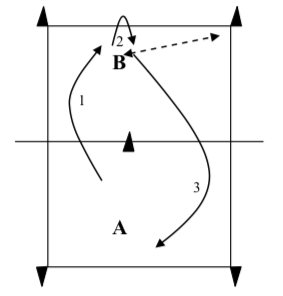
Possible variations:
- Play the ball after bumps
- Playing the ball after picking
- Playing the ball after catching without bots
- Play with 2 balls
Note: depending on the level we can differentiate and let the better players play with a handicap.
variation on Kings Court: winners move to winners field, losers move out and 3 new players move in.
- 3 players per half (whole field)
- trainer puts 1st ball in field of new team
- max 2 plays per half
- no smashing, no jumping, no lobs
- communication per team is a necessity
- The whole field must be defended (is feasible).
- balls coming from the other side are not hard but placed.
- there's a line,
- they throw the ball to the playmaker,
- who plays the ball to the attacker.
- who plays(!) not hit. over the net.
- Later you can attack.
